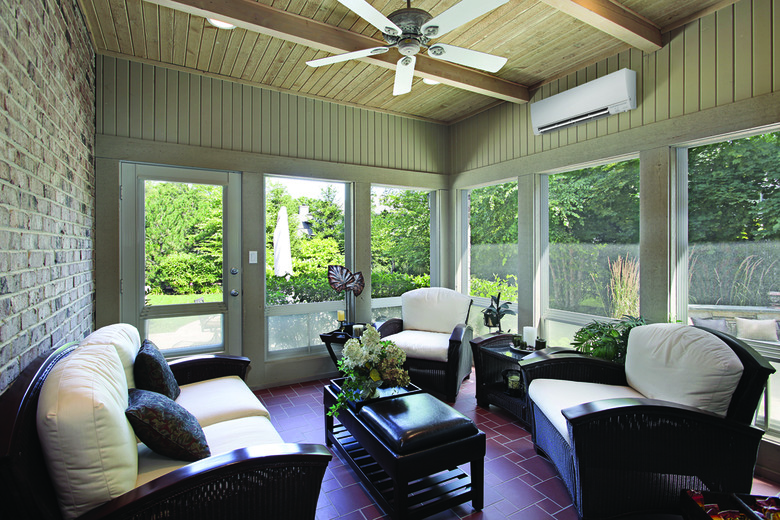Ductless Air Conditioning Systems: What You Need To Know
Wondering if ductless air conditioning systems could be the right solution to help you keep your cool? There are many ways to add air conditioning to a home, from popping in a window unit to cool one room to retrofitting central air into an existing house. One way that's becoming more popular because it solves some of the problems associated with traditional methods is cooling with ductless, or mini-split systems. Choosing a ductless air conditioner lets you cool your home without the need for ductwork.
Ductless Air Conditioning Systems
Ductless Air Conditioning Systems
As with standard central air-conditioning systems, ductless systems consist of an outside unit that contains the compressor and condenser and an inside air-handling component. But as the name implies, there are no ducts involved and no central blower/air handler.
Wall-mounted air handlers are connected directly to the outside units. There could be one air-handling unit that cools one room or as many as eight connected to a single exterior compressor, depending on the system.
This flexibility gives you several options to either cool a single space or use the ductless system as your primary cooling method. You can install one unit to cool a room addition or an attic or basement that is turned into living space. Or, multiple units can cool an entire house.
Why to Consider Ductless Systems
Why to Consider Ductless Systems
As with any system, ductless heating and cooling units come with pros and cons. Here are some of the advantages of ductless mini-split systems.
No ducts. Because there are is no ductwork, there are no duct leaks. Leaky ducts can make a central air-conditioning system about 20 to 30 percent less efficient.
Easier installation. Another benefit of a ductless installation is the relatively easy installation. After setting up the exterior compressor/condenser unit and mounting the air handlers inside, the HVAC contractor connects the two by an encased bundle that consists of thin refrigerant coils, wiring and a plastic tube that drains away condensate produced by the air handler. It only takes a three-inch diameter hole drilled through the wall of the house to handle this bundle. Outside, a plastic sheath attached to the house siding hides the bundle.
By contrast, in a typical central air retrofit in a house without existing ducts, new ducts have to be installed. Running these new ducts through closets where possible is a common technique, but installing new ductwork is generally a laborious and expensive process.
Pinpoint cooling (and heating, with some units). Each air handler is controlled separately, so you can put the cool only where you need it. This arrangement allows the homeowner to create zones that are each cooled to a different temperature — no need to waste energy on rooms that aren't occupied. Some units have variable speed compressors to improve energy efficiency.
Heating option available. Some models can provide both heating and cooling. So the advantages of zoned cooling can be applied to heating as well. Units that also offer heating contain a heat pump — a system that produces more energy than it consumes in electricity.
When in heating mode, a heat pump uses about 60 percent less energy than electric resistance heating, making this a more efficient option than baseboard heating or electrical space heaters. Older heat pumps lost their effectiveness once the temperature dropped to around freezing. But newer models can now operate in below-zero temperatures. Some heat pump models may qualify for local rebates.
Control options. Each air handler is controlled by a hand-held remote. There are some models that have wi-fi capability, so you can even control the unit with your smartphone. A few companies have products that monitor the temperature of the room to adjust the heating or cooling accordingly.
Disadvantages of Ductless Systems
Disadvantages of Ductless Systems
There are cases where a traditional air-conditioning system is a better choice than ductless units. Here are some disadvantages of mini-splits.
Expensive. Comparing air conditioner costs often reveals that a ductless system is on the high end. A ductless system with one air handler is about twice the cost of a good-quality window air conditioner. A ductless system to cool the whole house will run about 30 percent more than a traditional central air system if ductwork is already in place. The equation changes if new ducts need to be installed. Then, a ductless system may be less expensive than a traditional central air system.
Finding installers. Ductless systems have been used in Europe and Asia for decades. And while they're not exactly new to the U.S. market, they're new enough that not all HVAC contractors have experience installing or servicing them. Fortunately, this situation is changing as manufacturers have stepped up training HVAC technicians in the use of their products.
A different look. One advantage of central air is that it's mostly invisible in the living area. It's so invisible, in fact, that homeowners sometimes inadvertently block vents with furniture or drapes. The air handlers for ductless systems are in full view, whether mounted on the wall, the ceiling or the floor. Some people may object to the unit being so prominent in the room. The air handlers are, however, less obvious (and quieter) than typical window air conditioners.
Inconvenient maintenance. As with all air-conditioners, ductless air handlers contain filters that need to be washed with many manufacturers recommending monthly cleaning. But many air handlers are mounted high on walls, usually very close to the ceiling. The location and the need for a step stool or ladder to reach the unit could be enough of an excuse to put off air conditioner maintenance until later.
Ductless (mini-split) air conditioning and heating systems are a viable alternative to traditional window and central air-conditioning systems, especially in remodeling or retrofit projects. Discuss your project with a qualified contractor who has experience with both types of systems.
